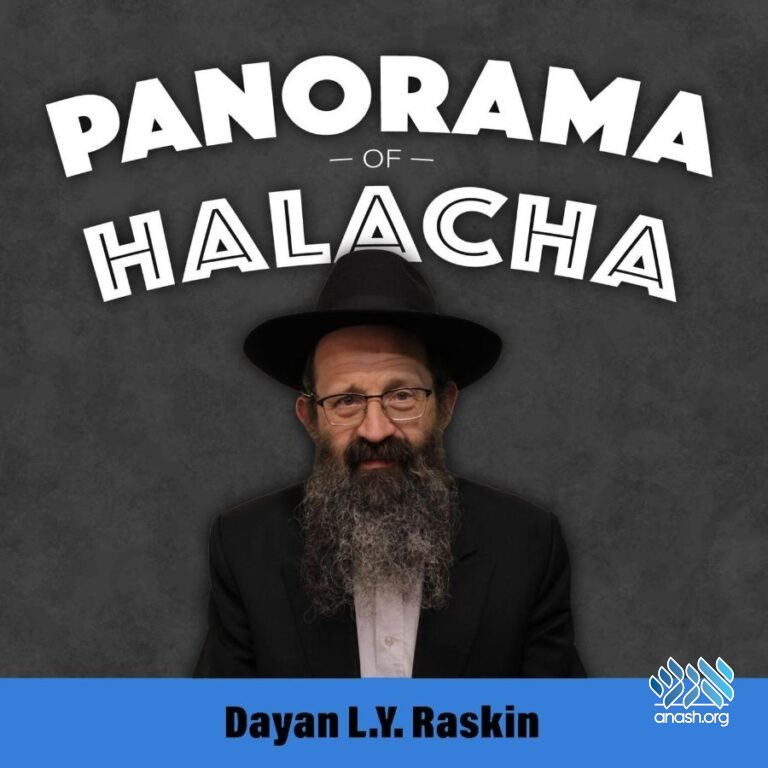Anash.org feature: Dayan Levi Yitzchok Raskin, Rov of Anash in London, explores interesting Torah questions and halachic dilemmas including visiting the Sistine Chapel, lighting Yom Tov candles late, building a sukkah in a yard shared with non-Jews, and asking a non-Jew to turn on a hotplate after shkiah.
The following issues are discussed by Rabbi Raskin in this week’s episode:
- In Selichos and in Hoshanos, in the alphabetical poem למען אמתך, למען בריתך, why does the third stanza have two concepts: למען גדלך ותפארתך?
- How do I measure for the placement of a Mezuza in a doorway that has straight doorposts but a curved arch for the lintel: a) the top 3rd of the straight doorposts; b) the top 3rd including the upper arch?[1]
- When a Jewish boy was circumcised by a non-Jew, there is a follow-on procedure called הטפת דם ברית. Are any brochos said when the above is done?[2]
- Chabad custom is that the Chazan falls silent at the end of אהבת עולם, but says גאל ישראל aloud – and the congregation find solutions to avoid answering אמן. Why the difference?[3]
- On Yom Kipur at Negel Vasser we wash just the fingers. But a Kohein washes until the wrist.[4] Is that at the first washing or at the second washing?
- I live in an apartment building with non-Jewish neighbors. I wish to build a Succah in the shared open space. Do I need to ask for their permission?[5]
- May a student of architecture visit the Sistine Chapel?[6]
- If my guests arrive late on the night of Yomtov, may they light candles then?[7]
- It was ten minutes after sunset on Friday when I realized that the hotplate hadn’t been switched on. May I ask a non-Jew to do so for me?[8]
- Hakhel!!!?[9]
To listen to Panorama of Halacha on a podcast, click here.
[1] ראה ס’ שכל טוב סי’ רפז ס”ק מד.
[2] ראה יו”ד סי’ רסח ס”א שאין מברכים. ובש”ך שם: לפי שאינו חיוב ברור. וע”ש ר”ס רסד. וע”ע אנציקלופדי’ תלמודית בערכו (כרך ט ע’ לה).
[3] בספר הפסק בתפלה מבאר שם הרב למברג, שב’גאל ישראל’ יש העצה בפוסקים שהקהל יסיימו הברכה יחד עם הש”ץ, לכן יכול הש”ץ לסיים בקול. משא”כ ב’הבוחר בעמו ישראל באהבה’ שלא כתבו הפוסקים עצה זו, על כן נאלצנו לסיים ברכה זו בלחש.
עוד י”ל על פי המובא בס’ אוצר מנהגי חב”ד-תשרי (ע’ צה) בשם הרה”צ הר”ר מאיר מפרעמישלאן זי”ע שהספק שבשו”ע (סי’ קיא) לענין עניית ‘אמן’ על ברכה זו היה בימים עתה, אבל עתה רוצים בשמים שיהודים יצעקו בקול רם: ‘גאל ישראל’.
[4] קיצור שו”ע סי’ קלג ס”ד; אוצר מנהגי חב”ד-תשרי ע’ ריז.
[5] ראה שוע”ר סי’ תרלז סי”א; משנ”ב מהדורת דרשו שם הע’ 12.
[6] שו”ע יו”ד סי’ קמט ס”ב; נתיבים בשדה השליחות ח”א פרק טז.
[7] ראה פסקי תשובות סי’ תקיד ס”ק (יט) [כג]; נתיבים בשדה השליחות ח”ג פ”ג הע’ 18.


Discussion
In keeping in line with the Rabbonim's policies for websites, we do not allow comments. However, our Rabbonim have approved of including input on articles of substance (Torah, history, memories etc.)
We appreciate your feedback. If you have any additional information to contribute to this article, it will be added below.